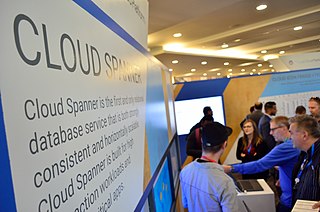Related Research Articles

zlib is a software library used for data compression as well as a data format. zlib was written by Jean-loup Gailly and Mark Adler and is an abstraction of the DEFLATE compression algorithm used in their gzip file compression program. zlib is also a crucial component of many software platforms, including Linux, macOS, and iOS. It has also been used in gaming consoles such as the PlayStation 4, PlayStation 3, Wii U, Wii, Xbox One and Xbox 360.

Db2 is a family of data management products, including database servers, developed by IBM. It initially supported the relational model, but was extended to support object–relational features and non-relational structures like JSON and XML. The brand name was originally styled as DB/2, then DB2 until 2017 and finally changed to its present form.
A distributed data store is a computer network where information is stored on more than one node, often in a replicated fashion. It is usually specifically used to refer to either a distributed database where users store information on a number of nodes, or a computer network in which users store information on a number of peer network nodes.
HBase is an open-source non-relational distributed database modeled after Google's Bigtable and written in Java. It is developed as part of Apache Software Foundation's Apache Hadoop project and runs on top of HDFS or Alluxio, providing Bigtable-like capabilities for Hadoop. That is, it provides a fault-tolerant way of storing large quantities of sparse data.

Cassandra is a free and open-source, distributed, wide-column store, NoSQL database management system designed to handle large amounts of data across many commodity servers, providing high availability with no single point of failure. Cassandra offers support for clusters spanning multiple datacenters, with asynchronous masterless replication allowing low latency operations for all clients. Cassandra was designed to implement a combination of Amazon's Dynamo distributed storage and replication techniques combined with Google's Bigtable data and storage engine model.

Exasol is an analytics database management software company. Its product is called Exasol, an in-memory, column-oriented, relational database management system
A database shard, or simply a shard, is a horizontal partition of data in a database or search engine. Each shard is held on a separate database server instance, to spread load.

Vertica is an analytic database management software company. Vertica was founded in 2005 by the database researcher Michael Stonebraker with Andrew Palmer as the founding CEO. Ralph Breslauer and Christopher P. Lynch served as CEOs later on.
A NoSQL database provides a mechanism for storage and retrieval of data that is modeled in means other than the tabular relations used in relational databases. Such databases have existed since the late 1960s, but the name "NoSQL" was only coined in the early 21st century, triggered by the needs of Web 2.0 companies. NoSQL databases are increasingly used in big data and real-time web applications. NoSQL systems are also sometimes called Not only SQL to emphasize that they may support SQL-like query languages or sit alongside SQL databases in polyglot-persistent architectures.

Couchbase Server, originally known as Membase, is an open-source, distributed multi-model NoSQL document-oriented database software package optimized for interactive applications. These applications may serve many concurrent users by creating, storing, retrieving, aggregating, manipulating and presenting data. In support of these kinds of application needs, Couchbase Server is designed to provide easy-to-scale key-value, or JSON document access, with low latency and high sustainability throughput. It is designed to be clustered from a single machine to very large-scale deployments spanning many machines.
LevelDB is an open-source on-disk key-value store written by Google fellows Jeffrey Dean and Sanjay Ghemawat. Inspired by Bigtable, LevelDB is hosted on GitHub under the New BSD License and has been ported to a variety of Unix-based systems, macOS, Windows, and Android.
Apache Accumulo is a highly scalable sorted, distributed key-value store based on Google's Bigtable. It is a system built on top of Apache Hadoop, Apache ZooKeeper, and Apache Thrift. Written in Java, Accumulo has cell-level access labels and server-side programming mechanisms. According to DB-Engines ranking, Accumulo is the third most popular NoSQL wide column store behind Apache Cassandra and HBase and the 67th most popular database engine of any type (complete) as of 2018.
The following is provided as an overview of and topical guide to databases:

SingleStore is a proprietary, cloud-native database designed for data-intensive applications. A distributed, relational, SQL database management system (RDBMS) that features ANSI SQL support, it is known for speed in data ingest, transaction processing, and query processing.

Apache Drill is an open-source software framework that supports data-intensive distributed applications for interactive analysis of large-scale datasets. Built chiefly by contributions from developers from MapR, Drill is inspired by Google's Dremel system. Drill is an Apache top-level project. Tom Shiran is the founder of the Apache Drill Project. It was designated an Apache Software Foundation top-level project in December 2016.

Spanner is a distributed SQL database management and storage service developed by Google. It provides features such as global transactions, strongly consistent reads, and automatic multi-site replication and failover. Spanner is used in Google F1, the database for its advertising business Google Ads.
The following outline is provided as an overview of and topical guide to MySQL:
A wide-column store is a column-oriented DBMS and therefore a special type of NoSQL database. It uses tables, rows, and columns, but unlike a relational database, the names and format of the columns can vary from row to row in the same table. A wide-column store can be interpreted as a two-dimensional key–value store. Google's Bigtable is one of the prototypical examples of a wide-column store.
Database scalability is the ability of a database to handle changing demands by adding/removing resources. Databases use a host of techniques to cope.
A distributed SQL database is a single relational database which replicates data across multiple servers. Distributed SQL databases are strongly consistent and most support consistency across racks, data centers, and wide area networks including cloud availability zones and cloud geographic zones. Distributed SQL databases typically use the Paxos or Raft algorithms to achieve consensus across multiple nodes.
References
- ↑ Hitchcock, Andrew, Google's Bigtable , retrieved 29 July 2007,
First an overview. Bigtable has been in development since early 2004 and has been in active use for about eight months (about February 2005).
. - 1 2 "Announcing Google Cloud Bigtable: The same database that powers Google Search, Gmail and Analytics is now available on Google Cloud Platform". Google Blog. 6 May 2015. Retrieved 21 September 2016.
- 1 2 Chang et al. 2006.
- ↑ Chang et al. 2006, p. 3: 'Bigtable can be used with MapReduce, a framework for running large-scale parallel computations developed at Google. We have written a set of wrappers that allow a Bigtable to be used both as an input source and as an output target for MapReduce jobs'
- ↑ Hitchcock, Andrew, Google's Bigtable , retrieved 29 July 2007,
There are currently around 100 cells for services such as Print, Search History, Maps, and Orkut
. - ↑ Cordes, Kyle (12 July 2007), YouTube Scalability (talk),
Their new solution for thumbnails is to use Google's Bigtable, which provides high performance for a large number of rows, fault tolerance, caching, etc. This is a nice (and rare?) example of actual synergy in an acquisition.
. - ↑ "How Entities and Indexes are Stored", Google App Engine, Google Code, archived from the original on 7 January 2012, retrieved 17 April 2014.
- ↑ Chang et al. 2006, Conclusion: 'We have described Bigtable, a distributed system for storing structured data at Google... Our users like the performance and high availability provided by the Bigtable implementation, and that they can scale the capacity of their clusters by simply adding more machines to the system as their resource demands change over time... Finally, we have found that there are significant advantages to building our own storage solution at Google. We have gotten a substantial amount of flexibility from designing our own data model for Bigtable.'
- ↑ Shute, Jeffrey 'Jeff'; Oancea, Mircea; Ellner, Stephan; Handy, Benjamin 'Ben'; Rollins, Eric; Samwel, Bart; Vingralek, Radek; Whipkey, Chad; Chen, Xin; Jegerlehner, Beat; Littlefield, Kyle; Tong, Phoenix (2012), "Summary; F1 — the Fault-Tolerant Distributed RDBMS Supporting Google's Ad Business", Research (presentation), Sigmod, p. 19,
We've moved a large and critical application suite from MySQL to F1
{{citation}}: CS1 maint: location missing publisher (link). - ↑ "Cloud Bigtable now even easier to manage with autoscaling".
- ↑ Kerner, Sean Michael (27 January 2022). "Google scales up Cloud Bigtable NoSQL database". TechTarget . Retrieved 10 October 2022.
- ↑ "Google File System and Bigtable", Radar (World Wide Web log), Database War Stories, O'Reilly, May 2006.
- ↑ "Google Bigtable, Compression, Zippy and BMDiff". 12 October 2008. Archived from the original on 1 May 2013. Retrieved 14 April 2015..
- ↑ Bentley, Jon; McIlroy, Douglas (1999). Data compression using long common strings. DCC '99: Proceedings of the Conference on Data Compression. IEEE Computer Society. CiteSeerX 10.1.1.11.8470 . doi:10.1109/DCC.1999.755678.
- ↑ "Google's Bigtable", Outer court (Weblog), 23 October 2005.
- ↑ Snappy (project).